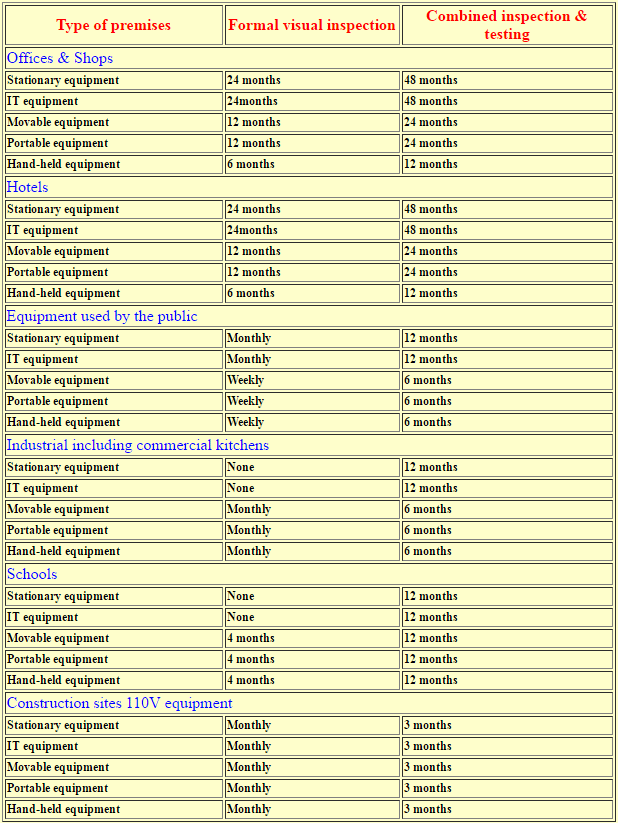Electrical Testing
PAT Testing
Portable Appliance Testing - Introduction
The Health & Safety Executive states that 25% of all reportable electrical accidents involve portable appliances. The Electricity at Work Regulations place a legal responsibility on employers, employees and self-employed persons to comply with the provisions of the regulations and take reasonably practicable steps to ensure that no danger results from the use of such equipment. This in effect requires the implementation of a systematic and regular program of maintenance, inspection and testing. The Health & Safety at Work Act (1974) places a clear responsibility on both occupiers of premises and employers to ensure that the workplace is maintained in a safe condition to protect employees, visitors, trainees, guests and cleaners from danger.
Portable Appliance Testing - Who is responsible
The Provision and Use of Work Equipment Regulations 1998 (PUWER) requires, every employer to ensure that work equipment is suitable for the purpose for which it is provided, only used in the place and under the provisions for which it is provided. It also requires every employer to ensure work equipment be efficiently maintained and kept fit and suitable for its intended purpose. It must not be allowed to deteriorate in function or performance to such a level that it puts people at risk. This means that regular, routine and planned maintenance regimes must be considered if hazardous problems can arise.
Regulation 3 of the Electricity at Work Regulations 1989 recognises a responsibility that employers and many employees have for electrical systems.
"It shall be the duty of every employer and self employed person to comply with the provisions of the Regulations in as far as they relate to matters which are within his control.
It shall be the duty of every employee while at work:
(a) to co-operate with his employer so far as is necessary to enable and duty placed on that employer by the provision of the Regulations to be complied with: and
(b) to comply with the provision of these regulations in so far as they relate to matters which are within his control."
Portable Appliance Testing - Types of Appliance
For the purpose of the legislation a portable electrical appliance is taken to be an item of equipment which is not part of a fixed installation but is, or is intended to be, connected to a fixed installation, or a generator, by means of a flexible cable and a plug and socket. This basically means that any item with a plug is a Portable Appliance. This would include electric drills, kettles, PCs, printers, monitors, extension leads and even some large items such as vending machines are classed as portable.
Portable Appliance Testing - Frequency Assessing
There is no specific schedule set out. There are however guidelines to help. The frequency of testing depends on the type of equipment and the environment in which it is used. For example a high-risk item such as an electric drill should be tested more frequently than a low risk item such as a PC. Furthermore a drill that is used everyday in a high density manufacturing plant should be tested more frequently than a drill used only occasionally in an office environment.

Electrical Inspections
What is fixed installation testing?
Fixed Installation Testing (FIT) involves testing the electrical services and systems that conduct electricity around a building.
It covers all the hard wiring in a building, whether that building is commercial, industrial or residential.
Anything electrical in a building that is fixed such as lighting, socket outlets, air conditioning and other fixed plant needs to be tested.
Upon completion of the electrical testing, a 'periodic inspection and test report' is issued. The routine inspection and testing of your fixed electrical installation, ensures compliance under the Health and Safety at Work Act 1974, the Electricity at Work Regulations 1989 and the Consumer Protection Act 1987. Electrical installation testing is also a common requirement for business and public premises insurance.
How can it benefit my business?
Owners of buildings have a duty of care to users. The wiring of buildings is an area that is often taken for granted, yet it can be a big cause of fire or injury through electric shocks.
The Electricity at Work Act, 1989 states that all electrical systems and equipment used in the working environment should be in a safe condition. The Health & Safety Executive recommend that to comply with the regulations, an inspection and testing programme should be undertaken at all places of work.
Many insurance companies are demanding electrical installation safety reports before re-insuring buildings.
What is the legal requirement for FIT?
The legal requirements are enshrined in the Electricity at Work Act, 1989 and the Health and Safety at Work Act, 1974.
The requirements for fixed installation testing are contained within the Institution of Electrical Engineers 17th Edition, Wiring Regulations (BS 7671) Guidance Note 3.

